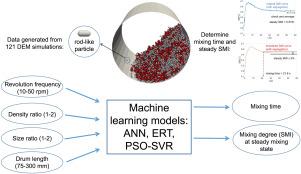Prediction of rod-like particle mixing in rotary drums by three machine learning methods based on DEM simulation data
IF 4.5
2区 工程技术
Q2 ENGINEERING, CHEMICAL
引用次数: 0
Abstract
The mixing of non-spherical particles in rotary drums exhibits significant complexity, particularly when density segregation and size segregation occur simultaneously. Three machine learning models: artificial neural network (ANN), extremely randomized trees (ERT), and particle swarm optimized support vector regression (PSO-SVR) were developed to predict the mixing time and mixing degree at the steady mixing state of rod-like particles in rotary drums. The training, validation, and test data for the machine learning models were generated from 121 discrete element method (DEM) simulations with four independent variables: revolution frequency, particle density ratio, particle size ratio, and drum length. All three models predicted the mixing degree accurately with 0.94. The ERT and PSO-SVR models also predicted the mixing time well with 0.88. Building machine learning models is hundreds of times faster than running DEM simulations, making these models highly promising for predicting larger-scale simulations with more complex-shaped particles.

基于 DEM 仿真数据的三种机器学习方法预测旋转滚筒中的棒状颗粒混合情况
非球形颗粒在旋转滚筒中的混合过程非常复杂,尤其是当密度偏析和粒度偏析同时发生时。本研究开发了三种机器学习模型:人工神经网络(ANN)、极随机树(ERT)和粒子群优化支持向量回归(PSO-SVR),用于预测旋转滚筒中棒状颗粒在稳定混合状态下的混合时间和混合程度。机器学习模型的训练、验证和测试数据来自 121 个离散元法(DEM)模拟,其中有四个自变量:旋转频率、颗粒密度比、颗粒尺寸比和转鼓长度。三个模型都能准确预测混合度,R2 ≥ 0.94。ERT 和 PSO-SVR 模型也能很好地预测混合时间,R2 ≥ 0.88。建立机器学习模型的速度比运行 DEM 模拟快数百倍,因此这些模型非常适合预测形状更复杂的粒子的更大规模模拟。
本文章由计算机程序翻译,如有差异,请以英文原文为准。
求助全文
约1分钟内获得全文
求助全文
来源期刊

Powder Technology
工程技术-工程:化工
CiteScore
9.90
自引率
15.40%
发文量
1047
审稿时长
46 days
期刊介绍:
Powder Technology is an International Journal on the Science and Technology of Wet and Dry Particulate Systems. Powder Technology publishes papers on all aspects of the formation of particles and their characterisation and on the study of systems containing particulate solids. No limitation is imposed on the size of the particles, which may range from nanometre scale, as in pigments or aerosols, to that of mined or quarried materials. The following list of topics is not intended to be comprehensive, but rather to indicate typical subjects which fall within the scope of the journal's interests:
Formation and synthesis of particles by precipitation and other methods.
Modification of particles by agglomeration, coating, comminution and attrition.
Characterisation of the size, shape, surface area, pore structure and strength of particles and agglomerates (including the origins and effects of inter particle forces).
Packing, failure, flow and permeability of assemblies of particles.
Particle-particle interactions and suspension rheology.
Handling and processing operations such as slurry flow, fluidization, pneumatic conveying.
Interactions between particles and their environment, including delivery of particulate products to the body.
Applications of particle technology in production of pharmaceuticals, chemicals, foods, pigments, structural, and functional materials and in environmental and energy related matters.
For materials-oriented contributions we are looking for articles revealing the effect of particle/powder characteristics (size, morphology and composition, in that order) on material performance or functionality and, ideally, comparison to any industrial standard.
 求助内容:
求助内容: 应助结果提醒方式:
应助结果提醒方式:


